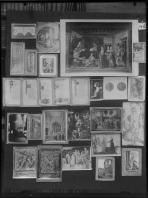Given the “hyper-link”-like, nonlinear structure of the Atlas in general and of each single panel in particular, the reading sequences proposed hereafter are not to be intended as a hierarchic Nacheinander (one-after-the-other), but merely as the unavoidable sequentialization due to the very nature of writing, which is unable to fully respect the iconic juxtaposition of the Nebeneinander (one-beside-the-other) of the Mnemosyne images.
As a first sequence we might address the simple action of a human body purposefully carrying something, as represented in: #6.2 (a female servant carrying a basket with fruit on her head in Ghirlandaio’s fresco in Florence's Santa Maria Novella), #11.1 and 11.2 (a female figure carrying something on her head portrayed in a Roman bas-relief inserted in a pillar of the church of San Zeno in Verona), #12 (a similar figure in the upper-left bas-relief of the Tavole Barberini), #13 (the detail of a woman carrying a fagot of wood extrapolated from Botticelli’s Temptation of Christin the Sistine Chapel), #14 (Lot’s daughters carrying a jug and a basket in Niccolò Tribolo’s bas-relief located on the portal of San Petronio in Bologna), #16 (a woman carrying a water container to help extinguish the fire in a drawing after Raphael’s The Fire in the Borgo), #17 (a woman carrying a vase on her head, in Agostino Veneziano’s engraving perhaps after Raphael), and finally #18 (a Tuscan countrywoman carrying a little bag with her right hand, photographed in Settignano near Florence by Warburg himself around 1900).
This simple action of carrying is highly remarkable from an evolutionary and anthropological point of view, since it distinguishes the human being from most, if not all, animal species: homo erectus, or homo sapiens, is constitutively homo ferens.
